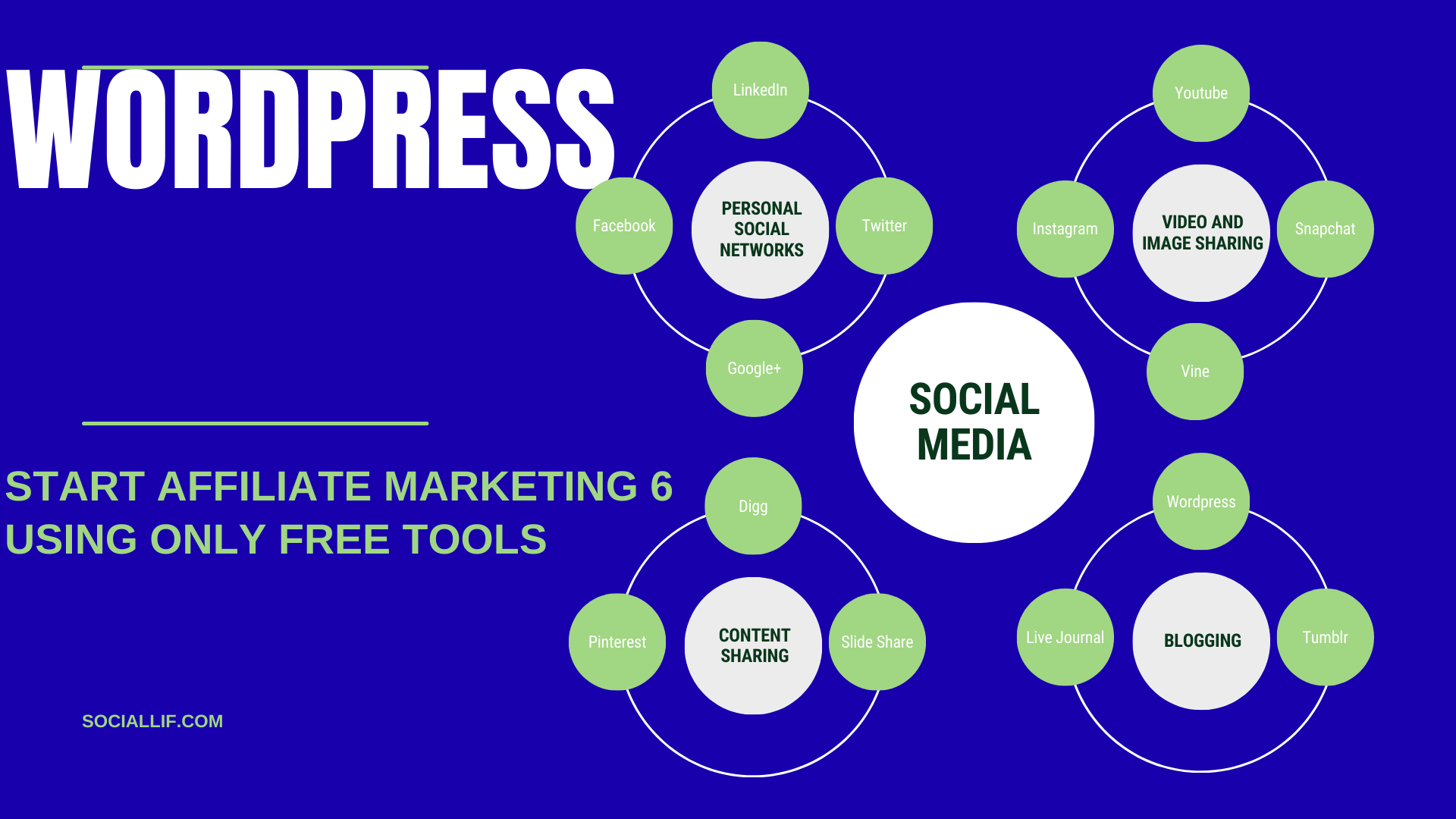Start Affiliate Marketing 6 Using Only Free Tools
Introduction
If you’re a student in 2025 looking for ways to earn money online, affiliate marketing is one of the best options to consider. The beauty of this model is that it doesn’t require a large budget or fancy paid tools to get started. At its core, affiliate marketing is very simple: you promote products or services from companies, and whenever someone buys through your unique referral link, you receive a commission.
Now, here’s the exciting part—you don’t need to spend anything upfront. Many students think they must invest in paid ads, buy expensive software, or hire professionals to create a website. The truth is, you can build your affiliate marketing business using only free tools and platforms that are already available. With the right approach, you can begin generating an income stream while still studying.
Why Students Are Choosing Affiliate Marketing
Affiliate marketing has become increasingly popular among students worldwide. Here are a few reasons why it’s such a good fit:
Low to zero investment – You can start with no money at all. Free platforms like WordPress.com, Canva, YouTube, TikTok, or even Instagram allow you to promote products without paying a single dollar.
Work from anywhere – Whether you’re in your dorm room, at a library, or relaxing at a café with Wi-Fi, you can run your affiliate business on your laptop or even your phone.
Learn practical skills – Along the way, you’ll develop digital marketing, communication, writing, and content creation skills. These are highly valuable and can boost your career prospects, even if you don’t continue affiliate marketing full-time.
Passive income potential – Once your affiliate links are set up in your blog posts, videos, or social media content, they can keep generating clicks and sales for months (or even years) with little ongoing effort.Picture starting your day by discovering you’ve made commissions while you slept—it’s truly rewarding!
Of course, it’s important to set realistic expectations. Affiliate marketing isn’t a shortcut to instant wealth. Many beginners give up because they expect instant results or rely on the wrong strategies. Like any business, it requires consistency, patience, and the right tools. The good news? You don’t have to do it blindly.
This guide will give you a step-by-step roadmap designed specifically for students. You’ll learn how to start affiliate marketing from scratch using free tools, how to pick the right niche, which platforms to use, and how to monetize your content effectively.
What You’ll Learn in This Guide
By the end of this article, you’ll understand:
What affiliate marketing really is (in simple terms).
Why students are in a great position to succeed at it.
Free tools and platforms you can use to get started immediately.
Strategies to promote your links without paid ads or big investments.
Monetization methods that fit student-friendly niches.
Mistakes beginners make and how to avoid them.
Real-life use cases that show how students have made affiliate marketing work for them.
Practical tips, FAQs, and comparisons to help you choose the right approach.
👉 Whether you’re a business major looking to practice real marketing skills, a computer science student wanting to explore online opportunities, or someone studying arts and creativity, affiliate marketing can help you turn your knowledge and hobbies into income.
Let’s break it down step by step.

What Is Affiliate Marketing? (For Beginners)
In the simplest terms, affiliate marketing is a collaboration where you, as the affiliate, recommend a company’s product or service. In return, you earn a percentage of the sales made through your unique referral link.
Think of it like being a brand ambassador—but instead of being paid a fixed salary, you’re paid based on performance. Your earnings grow with the number of sales or sign-ups you bring in.
The Key Players in Affiliate Marketing
Merchant (Advertiser) – This is the company or brand that owns the product or service. For example, Amazon, Canva, or Bluehost.
Affiliate (You) – As a student affiliate marketer, your role is to promote the product to the right audience.
Customer – The person who clicks on your link and makes a purchase.
Affiliate Network (Optional) – Sometimes, companies use networks like CJ Affiliate or Impact to manage their affiliate programs and pay commissions.
A Quick Example
For example, imagine joining the Amazon Associates Program, which is Amazon’s official affiliate program. You write a short blog post or create a TikTok video recommending a study desk that’s perfect for small dorm rooms. You include your Amazon affiliate link in the content. When someone clicks the link and buys the desk, Amazon pays you a commission. That’s affiliate marketing in action!
Why Affiliate Marketing Is Perfect for Students
Students have a unique advantage when it comes to affiliate marketing. Here’s why:
1. No Financial Barriers
Unlike starting a physical business that requires investment in stock, rent, or equipment, affiliate marketing can be done with zero startup costs. You can begin with free platforms such as Google Sites, Medium, or WordPress.com.
2. Flexible Hours
Balancing studies, part-time jobs, and social life is already challenging. The good news? Affiliate marketing doesn’t demand strict hours. You can work on it in your free time—whether that’s late at night, between classes, or on weekends.
3. Builds Real-World Skills
Affiliate marketing is more than just selling. It teaches you how to:
Write persuasive content.
Create graphics and videos.
Analyze data to understand what works.
Build an online presence.
These are transferable skills you can highlight on your CV or even turn into a career in digital marketing.
4. Growth Potential
The internet gives students a global audience. You can start by promoting small, everyday products but later grow into bigger partnerships with brands in your niche. Some students even transform their affiliate side hustle into a full-time business after graduation.

Step-by-Step Guide: How to Start Affiliate Marketing Using Only Free Tools
Step 1: Choose a Profitable Niche
Before you even think about creating content or signing up for affiliate programs, the first and most important step is to choose a niche. Your niche is simply the specific topic or industry you’ll focus on. It acts like your “lane” in the online world—where your audience will recognize you as a trusted voice.
The mistake many beginners make is chasing the “highest paying niche” without considering whether they actually enjoy it. If you don’t care about the topic, you’ll run out of motivation quickly. Remember, affiliate marketing works best when you’re consistent. Writing blog posts, making videos, or creating graphics around something you dislike will feel like homework you don’t want to do.
Instead, ask yourself these questions before choosing a niche:
What do I already enjoy talking about? (fitness, gadgets, fashion, apps, etc.)
What do my friends usually ask me for advice on?
Would I still be excited to create content about this topic after six months?
Are there enough products in this niche that I can recommend?
👉 For students, here are some niches that are both fun and profitable:
Study gadgets and stationery – Think noise-canceling headphones, ergonomic study chairs, planners, and digital tools like iPads or tablets. Students love improving their study environment.
Fitness apps and workout gear – With busy schedules, many students prefer short home workouts. You could promote resistance bands, yoga mats, or fitness apps that guide 10-minute routines.
Software and digital tools – Programs like Grammarly, Canva, or AI writing assistants are widely used by students. They solve real problems, making them easy to recommend.
Budget-friendly fashion – College students often look for affordable but stylish outfits. You could promote online clothing stores with student discounts.
Personal finance and side hustles – Many students want to save or earn money. Promoting apps like budgeting tools, freelancing platforms, or investment apps can work well.
💡 Pro Tip: Don’t worry if your niche feels “too small.” A smaller, targeted niche can actually perform better than a broad one. For example, instead of promoting “all fitness,” focus on “home workouts for busy students.” The more specific you are, the easier it is to attract the right audience.

Step 2: Join Free Affiliate Programs
Once you’ve picked a niche, the next step is to join affiliate programs that fit your audience. The good news? Most programs are completely free to join. You don’t need to pay any membership fee—just apply, get approved, and start promoting products.
Here are some of the best beginner-friendly affiliate programs for students:
1. Amazon Associates
Amazon is one of the simplest platforms to begin with. Since they offer a wide range of products—covering books, electronics, fashion, and more—you can find items to promote no matter which niche you focus on.
Why it’s good for students: Trusted brand, easy to join, and massive product variety.
Commission rates: Typically 1–10% depending on the category.
Best for: Niches like study tools, gadgets, and fashion.
2. Canva Affiliate Program
If you’re into design, content creation, or social media marketing, Canva is a goldmine. Students already use it for presentations, posters, and Instagram posts. The affiliate program pays you when people sign up for Canva Pro.
Why it’s good for students: Canva is extremely popular among peers; easy to promote through tutorials or templates.
Commission: You can earn as much as $36 for every new Canva Pro subscriber you refer.
Best for: Design, business, and creative niches.
3. Impact & CJ Affiliate
These are affiliate networks that connect you with multiple brands at once. Instead of joining individual programs one by one, you can browse hundreds of companies in different industries.
Why it’s good for students: Access to big-name brands in software, fashion, and lifestyle.
Best for: Students who want to explore multiple niches before choosing one.
4. Grammarly Affiliate Program
Perfect for students in the education niche. Grammarly is an AI-powered writing tool that helps improve grammar, spelling, and writing style. It’s useful for essays, assignments, and even social media posts.
Why it’s good for students: Highly relevant to education; every student writes essays or assignments.
Commission:You can earn up to $20 for every free sign-up, with additional commissions available for premium plan upgrades.
Best for: Education, productivity, and blogging niches.
💡 Pro Tip: When you join these programs, make sure to read the rules. Some programs don’t allow you to put affiliate links directly on certain platforms (like email or PDFs). Always check the terms.
Step 3: Use Free Tools to Build Your Affiliate Business
Now comes the fun part—building your affiliate business using free tools. These tools will help you create content, track performance, and promote products without spending any money. Let’s explore the best ones:
1. WordPress.com (Free Website Builder)
Having your own blog or website gives you control and authority. WordPress.com’s free plan is a great starting point for students. You can create articles like “Top 5 Study Gadgets for College Students” and add your affiliate links naturally.
Pros: Free hosting, SEO-friendly, tons of themes.
Cons: Free version has limited customization.
Best for: Students who want to build a long-term blog.

2. Canva (Free Graphic Design Tool)
Canva is perfect for creating posters, infographics, and social media posts to showcase affiliate products. No design experience required—simply drag and drop to create.
- Pros: Offers thousands of free templates, user-friendly interface, and works smoothly on mobile devices.
Cons: Limited free stock photos and icons.
Best for: Students who want to design marketing material quickly.
3. Google Sites
Not ready to start a full blog? Google Sites lets you create free, simple landing pages where you can showcase affiliate links or product comparisons.
Pros: 100% free, easy integration with Google tools.
Cons: Very basic design options.
Best for: Quick affiliate landing pages.
4. Mailchimp (Free Email Marketing Tool)
Email marketing is highly effective as it helps you connect and build trust with your audience. With Mailchimp’s free plan, you can send newsletters to as many as 500 subscribers.
Pros: Easy drag-and-drop builder, automation tools.
Cons: Limited features on free plan.
Best for: Students who want to build an email list early.
5. CapCut (Free Video Editing Tool)
Video is one of the best ways to promote affiliate products in 2025. CapCut makes it easy to create TikToks, Instagram Reels, and YouTube Shorts showcasing your favorite products.
Pros: Free filters, transitions, AI tools.
Cons: Some templates add watermarks.
Best for: Students who want to use short-form video marketing.
6. Google Analytics
Knowing what works and what doesn’t is crucial. Google Analytics tracks website visitors, traffic sources, and engagement so you can improve your strategy.
Pros: Free and highly detailed insights.
Cons: Slight learning curve for beginners.
Best for: Students who want to track performance seriously.
Tool Comparison Table
| Tool | Best For | Pros | Cons |
|---|---|---|---|
| WordPress | Blogging, long-term growth | SEO-friendly, free themes | Limited customization free |
| Canva | Graphics, content marketing | Easy to use, free templates | Limited stock photos |
| Google Sites | Quick landing pages | Free, Google integration | Basic design only |
| Mailchimp | Email marketing | Free automation, easy setup | Limited contacts (500) |
| CapCut | Video promotion | Trendy effects, free to use | Watermark on some features |
| Analytics | Performance tracking | Free, detailed reports | Learning curve |
Start Affiliate Marketing 6 Using Only Free Tools Start Affiliate Marketing 6 Using Only Free Tools
Monetization Strategies for Students
Start with digital downloads (study planners, templates).
Promote software tools students already use.
Use YouTube Shorts & TikTok for product reviews.
Pinterest traffic for free blog visitors.
Common Mistakes Beginners Make
Copying designs directly from Canva without changes.
Spamming affiliate links everywhere.
Not using SEO keywords in blogs.
Giving up too soon without testing strategies.
Bonus Tips for Success
Be consistent with content (blogs, reels, pins).
Build trust by giving honest reviews.
Focus on one niche first before expanding.
Track your results with free analytics tools.
Real-Life Example
Let’s say a student named Ayesha starts a free WordPress blog about budget-friendly study gadgets. She signs up for Amazon Associates, reviews items like study lamps and laptop stands, and creates Pinterest graphics using Canva. She shares her posts on TikTok with short videos edited in CapCut. Within 3 months, Ayesha starts earning her first commissions—all without spending any money.
This shows how free tools + consistent effort = affiliate income for students.
FAQs (with Schema Ready)
Q1: Is it necessary to invest money to begin affiliate marketing?No, you can start completely free using tools like WordPress, Canva, and social media.
Q2: How much time does it usually take to start earning from affiliate marketing?
Usually 3–6 months with consistent effort.
Q3: Which niche is best for students?
Education tools, tech gadgets, fitness, and digital products are great for students.
Q4: Is it possible to start affiliate marketing without having a website?
Yes, you can start with social media platforms like Instagram, TikTok, and YouTube.
Q5: Is affiliate marketing legal for students?
Yes, it’s 100% legal as long as you disclose affiliate links.
Conclusion
In 2025, affiliate marketing has become easier and more approachable than ever before. With free tools like WordPress, Canva, CapCut, Mailchimp, and Google Sites, students can launch an online business without spending money. The key is to pick the right niche, use free platforms strategically, and stay consistent.
👉 Now it’s your turn:
Which free tool will you start with—WordPress for blogging, or TikTok + CapCut for videos? Share your choice in the comments below!
✅ Suggested External Links (trusted resources to boost SEO)
Start Affiliate Marketing 6 Using Only Free Tools Start Affiliate Marketing 6 Using Only Free Tools Start Affiliate Marketing 6 Using Only Free Tools Start Affiliate Marketing 6 Using Only Free Tools Start Affiliate Marketing 6 Using Only Free Tools Start Affiliate Marketing 6 Using Only Free Tools Start Affiliate Marketing 6 Using Only Free Tools Start Affiliate Marketing 6 Using Only Free Tools Start Affiliate Marketing 6 Using Only Free Tools Start Affiliate Marketing 6 Using Only Free Tools Start Affiliate Marketing 6 Using Only Free Tools Start Affiliate Marketing 6 Using Only Free Tools
Start Affiliate Marketing 6 Using Only Free Tools Start Affiliate Marketing 6 Using Only Free Tools Start Affiliate Marketing 6 Using Only Free Tools Start Affiliate Marketing 6 Using Only Free Tools Start Affiliate Marketing 6 Using Only Free Tools Start Affiliate Marketing 6 Using Only Free Tools Start Affiliate Marketing 6 Using Only Free Tools Start Affiliate Marketing 6 Using Only Free Tools Start Affiliate Marketing 6 Using Only Free Tools